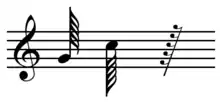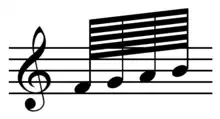


In music, a hundred twenty-eighth note (North American) or semihemidemisemiquaver[1][2] or quasihemidemisemiquaver[3] (British) is a note played for 1⁄128 of the duration of a whole note. It lasts half as long as a sixty-fourth note. It has a total of five flags or beams.
A single 128th note is always stemmed with flags, while two or more are usually beamed in groups.[4] Notes this short are very rare in printed music, but not unknown. One reason that notes with many beams are rare is that, for instance, a thirty-second note at ![]() = 50 lasts the same amount of time as a sixteenth note at
= 50 lasts the same amount of time as a sixteenth note at ![]() = 100; every note in a piece may be notated as twice as long but last the same amount of time if the tempo is also doubled. They are principally used for brief, rapid sections in slow movements. For example, they occur in the first movement of Beethoven's Pathétique Piano Sonata (Op. 13), to notate rapid scales. Another example is in Mozart's Variations on Je suis Lindor, where many of them are used in the slow twelfth variation.[5][6] Likewise, 128th notes are used in the explicitly notated ornamental runs in the opening Adagio of Bach's g minor Sonata for Unaccompanied Violin (BWV 1001).[7]
= 100; every note in a piece may be notated as twice as long but last the same amount of time if the tempo is also doubled. They are principally used for brief, rapid sections in slow movements. For example, they occur in the first movement of Beethoven's Pathétique Piano Sonata (Op. 13), to notate rapid scales. Another example is in Mozart's Variations on Je suis Lindor, where many of them are used in the slow twelfth variation.[5][6] Likewise, 128th notes are used in the explicitly notated ornamental runs in the opening Adagio of Bach's g minor Sonata for Unaccompanied Violin (BWV 1001).[7]
These five-beamed notes also appear occasionally where a passage is to be performed rapidly, but where the actual tempo is at the discretion of the performer rather than being a strict division of the beat. In such cases, the aggregate time of the notes may not add up exactly to a full measure, and the phrase may be marked with an odd time division to indicate this. Sometimes such notation is made using smaller notes, sized like grace notes. One rare instance where such five-beamed notes occur as acciaccaturas occurs in the final measures of No. 2 of Charles-Valentin Alkan's Trois grandes études, Op. 76.
Hundred twenty-eighth rests are also rare, but again not unknown. One is used in Beethoven's Piano Sonata No. 13 "Quasi una fantasia" (bar 24 in the adagio movement) where it is followed by an ascending run of 128th notes,[8] as well as in the finale of Charles-Valentin Alkan's Grande sonate 'Les quatre âges'.[9]
See also
References
- ↑ Read, Gardner (1979). Music Notation, p.65. 2nd edition. Crescendo Taplinger. ISBN 0-8008-5453-5.
- ↑ Haas, David (2011). "Shostakovich's Second Piano Sonata: A Composition Recital in Three Styles". In Fairclough, Pauline; Fanning, David (eds.). The Cambridge Companion to Shostakovich. Cambridge Companions to Music. Cambridge and New York: Cambridge University Press. p. 112. doi:10.1017/CCOL9780521842204.006. ISBN 978-1-139-00195-3.
The listener is right to suspect a Baroque reference when a double-dotted rhythmic gesture and semihemidemisemiquaver triplets appear to ornament the theme.
) - ↑ Miller, RJ (2015). Contemporary Orchestration: A Practical Guide to Instruments, Ensembles, and Musicians. Routledge. p. 38. ISBN 978-0-415-74190-3.
- ↑ Gerou, Tom (1996). Essential Dictionary of Music Notation, p.211. Alfred. ISBN 0-88284-730-9
- ↑ Mozart, Wolfgang Amadeus. 12 Variations on 'Je suis Lindor', K.354. p. 10, fourth system, last bar. Wolfgang Amadeus Mozarts Werke, Serie 21. Leipzig: Breitkopf & Härtel, 1877-1910. Plate W.A.M. 354.
- ↑ Thomas Bushnell BSG (8 November 2007). "Re: GPD: official shortest note in lilypond". mail-archive.com.
- ↑ Joel., Lester (1999). Bach's works for solo violin : style, structure, performance. New York: Oxford University Press. ISBN 0195120973. OCLC 39739608.
- ↑ Piano Sonata No. 13, Op. 27, No. 1 (Beethoven): Scores at the International Music Score Library Project
- ↑ https://imslp.org/wiki/Grande_Sonate_'Les_Quatre_Ages'%2C_Op.33_(Alkan%2C_Charles-Valentin)